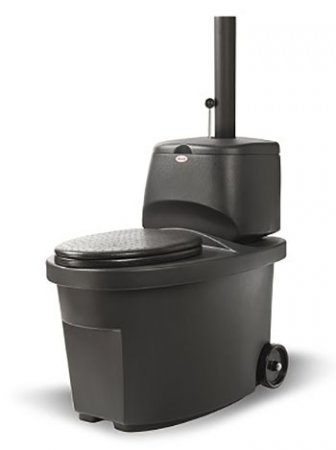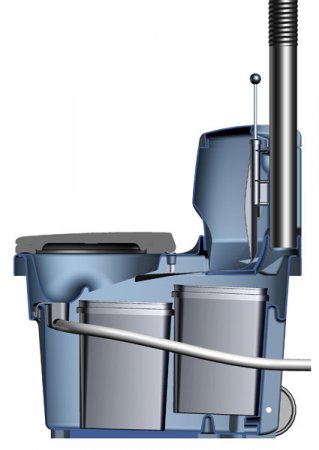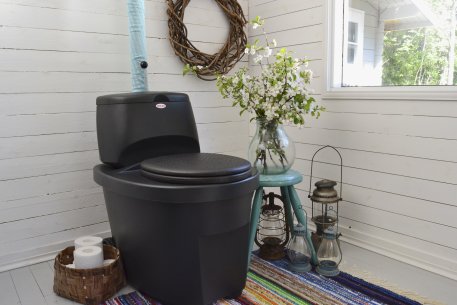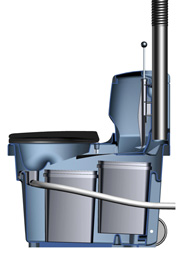Using the Biolan Separating Dry Toilet
The Separating Dry Toilet must be used and maintained in accordance with the instructions. This makes use and maintenance of the toilet more pleasant. Separation of the liquid and the solid waste requires that the Separating Dry Toilet must always be used in the seated position. When operating the unit for the first few times, the users should verify that their own seating distance and habits are suitable for it. Guests should also be instructed on how to use the toilet.
The Separating Dry Toilet is intended for composting toilet waste also including toilet paper. Do not put into the toilet anything that could hamper post-treatment of the toilet waste, such as:
- debris, sanitary towels
- chemicals, lime
- detergents, washing water
- ash, cigarette butts
Before use
Put a layer a couple of centimetres thick of the Biolan Komposti and Huussi Dry Bedding on the bottom of the foremost inner receptacle. Fill the bedding container with bedding.
Using bedding
The bedding batcher is located in the bedding container at the rear of the toilet unit. It is operated by depressing the batcher"s knob. The dry bedding does not need to be added every time the toilet is used; adding it after defecation is sufficient.
Applying suitable dry bedding is essential for proper operation of the toilet. We recommend using as bedding Biolan Komposti and Huussi Dry Bedding. The Komposti and Huussi Dry Bedding efficiently absorbs odours and keeps the toilet compost airy.
Year-round use of the toilet
A toilet, installed in a warm space, can be used around the year. This requires that thermal insulation of the ventilation and the liquid removal systems in cold spaces is taken into account.
A toilet, installed in a cold space, can freeze during winter. The toilet unit is manufactured of frost-proof polyethylene, so freezing does not damage it. A toilet, located in a cold space, can be used occasionally during winter. If the liquid is collected in a canister, the canister must be emptied in the autumn in order to avoid damage caused by freezing of the liquid. If the bedding in the container is moist, it may freeze during winter. Thus the batcher of the bedding will not work and the bedding needs to be added manually.
aintenance of the Separating Dry Toilet
The Separating Dry Toilet must be used and maintained in accordance with the instructions. This makes use and maintenance of the toilet more pleasant.
Emptying the inner receptacle
There are two separate inner receptacles inside the tank of the Separating Dry Toilet. Only one of them is used at a time. When one of the receptacles fills up, it is moved to the rear part of the unit and the other receptacle is put into use. As required, the surface of the waste can be levelled using, for example, a stick. The covers for the inner receptacles are intended for use while transporting the receptacles for emptying. Leave the cover ajar when storing. Once both the toilet receptacles have filled up, empty the one that filled up first into the compost.
Disconnect the toilet"s ventilation pipe from the top of the unit for emptying. Turn the top part of the toilet unit to the side or lift it away to enable the inner receptacles to be lifted out. There is no need to wash the inner receptacles when emptying them.
While putting the inner receptacles back, make sure that the receptacle that will be used is in the correct location against the separating bowl. Put a couple of centimetres thick layer of the Biolan Komposti and Huussi Dry Bedding on the bottom of the receptacle.
Emptying the liquid tank
Empty the liquid tank when necessary. The emptying intervals are determined by the size of the liquid tank and by how often the toilet is being used. One person produces 1-1,5 litres of liquid daily.
The liquid, rich in nutrients, in particular nitrogen, can be utilized as fertilizer in the yard and garden. Although urine is sterile, it is recommended to keep it in storage for about a year before using it in the garden. A small amount of undiluted liquid can be used as a source of nitrogen for the garden compost and the compost of separated toilet waste. Optionally the liquid can be taken to the wastewater treatment plant.
Cleaning the Separating Dry Toilet
The Separating Dry Toilet must be washed and cleaned when needed. Any common domestic cleaning agents can be used for cleaning. The toilet can be dismantled to enable proper cleaning. Wash the liquid bowl in the seat ring, the liquid funnel and the removal pipe with warm water and mild detergent or crystallized sodium at least once a year to remove any precipitate the urine has formed.






 A tidy toilet to be installed on the floor!
A tidy toilet to be installed on the floor!



 Placing the Separating Dry Toilet in the toilet space
Placing the Separating Dry Toilet in the toilet space